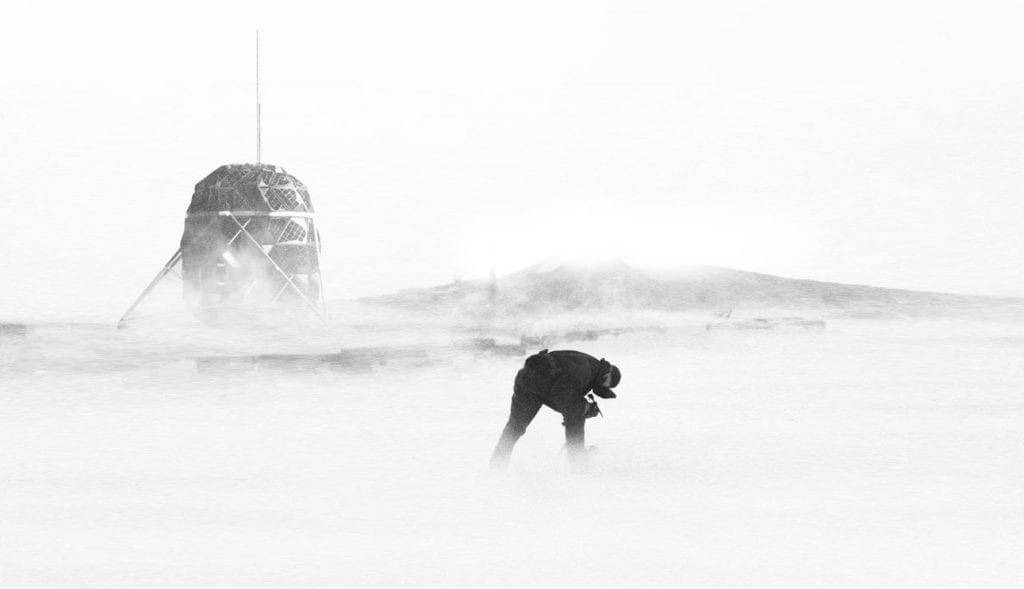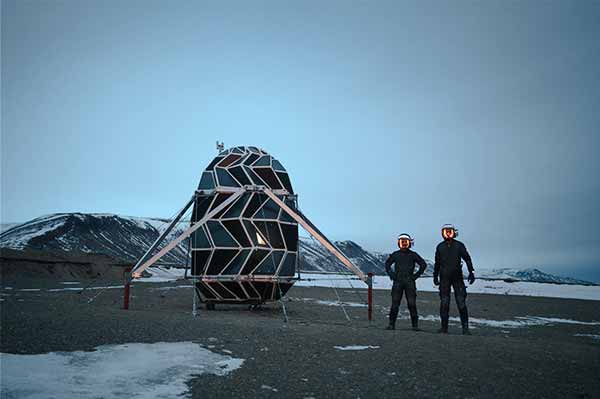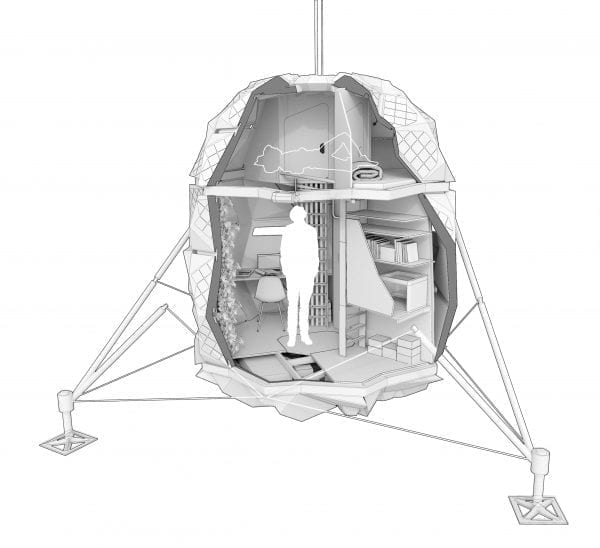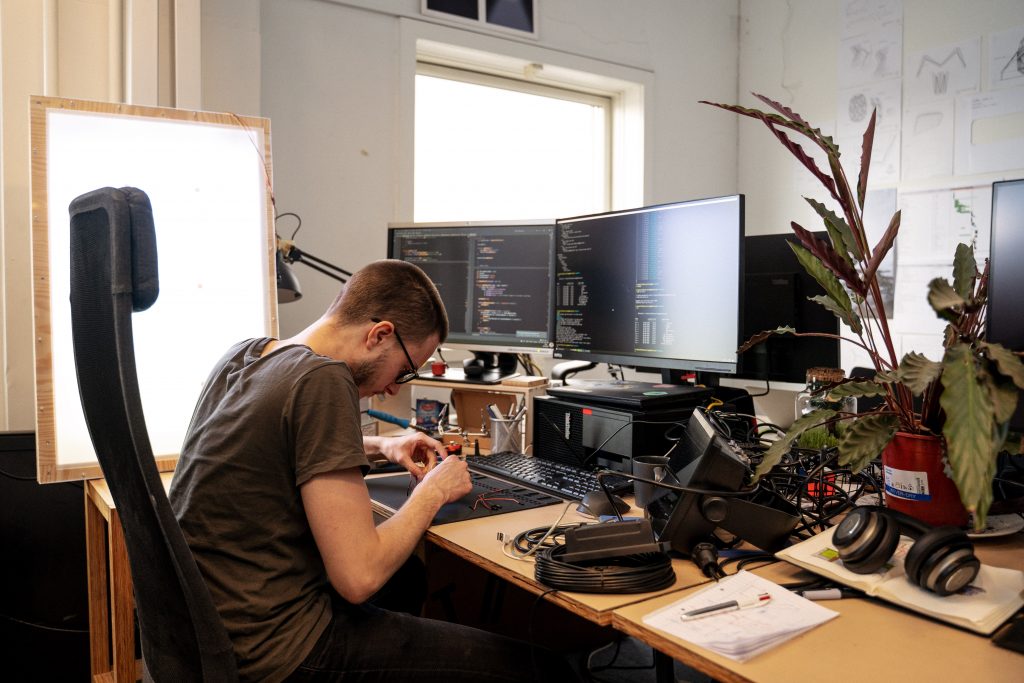In deepest Greenland the arid landscape stretches out, unchanging, for what looks like hundreds of miles. Hungry polar bears stalk the icy landscape, unforgiving winds blow at -30°C… and two Danes bundled in thick coats build an origami-inspired structure in the snow.
This isn’t the set-up for a punchline, but the reality for two architects who are testing a habitat, designed and built for future missions to the moon. Ahead of their journey into the arctic north of Greenland we caught up with one of the modern-day explorers, Sebastian Aristotelis, before he and his partner, Karl-Johan Sørensen, set out on their three-month arctic mission.

Reaching for the moon
Sitting in a hotel off the coast of Greenland, Sebastian lifts his laptop to show us the view from his window. The landscape of icebergs looks beautiful through our Google Hangouts window, but it serves as a reminder of the harsh conditions that lay ahead in one of the most difficult terrains on earth.
In talking to Sebastian, you cannot fail to be swept along by his enthusiasm and excitement. It doesn’t take long in his company to understand that this expedition is the culmination of years spent realising a dream he first had as a young boy.
“When I was a teenager, I read a quote that said my generation was born too late to explore the earth and too early to explore the universe,” he says.
“I remember that hit me really hard and knocked by dream offline for a few years while I focused on school and other ‘boring’ stuff. But years later – at the point when I was preparing to go to university to study architecture – suddenly there was a wealth of information online about how space travel was much more tangible for us than we thought.
“I started reading books by people like Robert Zubrin, who has dedicated his entire life to explaining why going to Mars is the most logical step for humans. I remember reading it and thinking: ‘This makes complete sense!’”
From there the rest, as they say, is history. As Sebastian puts it: “If I had been a film director, I would have made films about space. If I was a novelist I would write books about it. It just so happens that I’m an architect, so naturally I now work to build habitats and structures for space.”

The Habitat
The Lunark mission takes place in Moriusaq, an abandoned settlement in the arctic north of Greenland. The location was chosen because it represents the closest possible match on earth to the inhospitable conditions on the moon.
“We wanted it to be cold and difficult,” adds Sebastian. “The problem with other missions is that they become theatrical because the people involved can still go outside if they want.
“You can’t just go outside if you’re on the moon! For us to get the most realistic experience we wanted the landscape to be completely monotone, like the moon. We wanted it to be completely isolated. There are only two places in the world which fit that description: the North and South Poles.
“The planned destination for the first Moon settlements is the South pole of the Moon, known as the Peak of Eternal Light. Here the sun shines over 80% of the time, similar to the conditions in Moriusaq.”

On the mission website, the team point out that current missions carried out by the space industry do not involve real danger. The unique position of the Lunark mission is that they are deliberately emulating the moon by making Sebastian and Karl “feel the struggle to survive in the extreme reality north of the arctic circle”. Sebastian is fully aware of the dangers, and how important it is to ensure the habitat structure is prepared for all scenarios.
“This structure is what will keep us alive over the next three months – so the consequences of something going wrong are really serious. When astronauts go to the international space station, they spend several years learning about the structure, systems and how to fix things if they go wrong as you can’t call on anyone else to help you.
“The good news is that there is no one in the world who knows the structure better than me and Karl. We have spent nine months designing and building this structure and know everything about it, down to every screw and bolt.”

“Houston, we have a problem…”
The habitat is built to withstand temperatures of -30°C along with wind speeds of 90 km/h and has to be durable enough to withstand any curious polar bears who cross its path.
Other features to keep Karl and Sebastian safe and healthy during the mission include: lighting which creates an artificial circadian rhythm (effectively mimicking normal daylight hours); a solar panel skin to maximise energy generation; a 3D printer that will enable the pair to print any parts they need to repair and maintain the habitat; multiples of everything, especially its battery generators.
The brain of the habitat is Odin, the Lenovo-powered IoT guardian that “speaks” for the habitat and provides an early warning system for any difficulties they may face during the mission. Named after the all-seeing god of Norse mythology, it is a ThinkCentre M90n Nano which constantly collects and processes data from 76 sensors (which Karl and Sebastian have dubbed “ravens”, after the mystical birds that Odin sends out to gather information).
In early September, the pair reached their base camp aboard one of the Danish Arctic Military’s ice-breaking battleships. But two weeks into the mission the sea froze over, leaving them alone with just Odin, his ravens and two high-powered Thinkpad P53 laptops for company. Their only connection to the outside world is a satellite phone, but this presents challenges of its own as the phone only works outside, so as weather conditions deteriorate this will be especially difficult.

“Our CTO, Simon Kristensen, is our ‘ground control’ during the mission,” says Sebastian. “He knows the habitat as well as we do and has a list of all our medicine and first aid materials. He’s also our technology man and will be able to help us troubleshoot any issues with the habitat.
“We have planned for us much as we can and have redundancies in place for everything in the habitat, especially for mission-critical things like energy.”
A vision for the future
For Sebastian, this trip is the tip of the iceberg for his space ambitions. He firmly believes that we will see commercial space travel within his lifetime.
“We definitely are entering into this mission with a strong desire to see a version of this habitat on the moon. In terms of a timeline I see humans stepping foot on the moon again in 2026 or 2027, with a more sustainable presence on the moon shortly thereafter.
With this comes a growing need for moon-ready habitats, base tourism and other commercial space opportunities.
“With the right people in place we could definitely make this a reality,” Sebastian concludes. “There are things we do really well but by collaborating with scientists, who specialise in rugged devices and mechanisms, we would be able to optimise the habitat even more, for example by putting landing gear in place that would enable us to get it to the moon in the first place.
“We might land a contract to design the moon habitat ourselves. That would be the dream.”
Over to you NASA!
